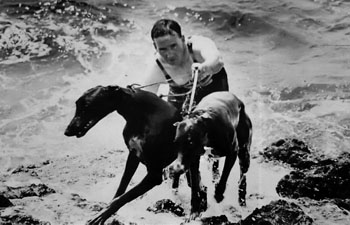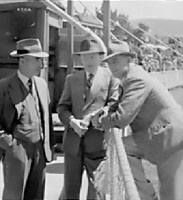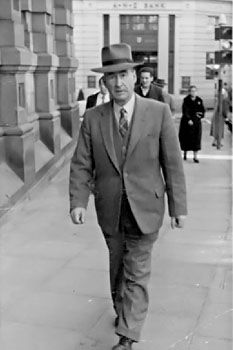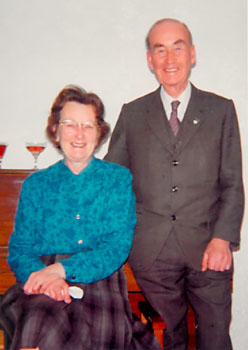M.A. “Arthur” Morgan
Inauguaral inductee to Hall Of Fame 2007
Clearly, Irishman Michael Arthur Morgan, who had turned sixteen the day left for Australia in 1921, shaped the face of Greyhound Racing in Tasmania more than any other contributor. He was the founding father of track racing as we know it today.

Arthur as a trainer in his early days
An Irish newspaper article in 1966 mentioned his interest in coursing from the age of eleven, and he worked in his father’s shop from the age of twelve.
A man of many colours (including being a magistrate) and with a great interest in open coursing, Morgan assisted Jack Nelson in the establishing the White City Speed Coursing Track in 1932.In fact, Morgan won a race on the opening night, February 8 1933, with a dog called Authorized.
Moving to Hobart he initiated the Hobart Speed Coursing Club in November 1933. He lobbied Premier A.G.Ogilvie to alter the Act to allow betting on Greyhound Racing, without which he realized the sport could not survive. He came to an agreement with the Tasmanian Cricket Association to lease that ground. He was overseer to the laying of the track, the lighting, the Judges box and all other issues necessary to the running of a race meeting.

Arthur (left) with Olympian and Course Commentator Bill Barwick, and Athol Munnings
Morgan was appointed Manager and Handicapper and on January 30 1935 Premier Ogilvie officially opened racing at Hobart. A reported crowd of 4000 people saw 46 dogs compete in 9 events with the MacRobertson Cup the feature. There was a hurdle race and ten bookmakers fielded.
From this initial meeting in 1935 until failing health saw him leave the helm in 1967 Arthur Morgan ruled Greyhound racing with an iron hand. Known as M.A. or Mr. Morgan, very few people called him Arthur. He demanded integrity on all matters and moved swiftly if anyone contravened his lofty standards.
In the early days he realized a shortage of dogs was a great concern and imported greyhounds not only from Victoria but indeed from Ireland which he sold on (sometimes below cost) to keep numbers viable. As profits grew, he grew the amenities. His endeavours led to the establishment of the Totalisator on course. He organised 10 dog starting boxes, a mechanical lure and in November 1948 Hobart was the first track in Australia to install a Photo Finish Camera. It was Morgan who lobbied the NCC to have compulsory ear branding of greyhounds which commenced in 1939.

Near the H.G.R.C.Offices at the T & G Building
All sorts of celebrities were regulars at the Hobart Greyhounds and Morgan saw that many and various charities were advantaged by money raised at the dogs. Morgan encouraged Mainland owners and trainers to race here AND they came.
Morgan realized the importance of a standout feature race. Thus the Hobart Cup was born in 1935 when won by S.Burton’s Elwick Boy. With a burning ambition to establish Hobart as the premier club in Australia he convinced the Committee to change the Hobart Cup to the Hobart Thousand in 1939 with an unheard of 500 pounds to the winner. Mr Whackles won it for Ray Austin beating the Victorian Jack Ayr.
It briefly reverted back to the Hobart Cup during the war years. When it again became the Hobart Thousand in 1946 the prize became what Morgan’s vision had always been — 1000 pounds. It went to Dick Baker’s Ebon’s Own. Morgan’s Hobart Thousand was for many years worth five times that of the Australian Cups’ 200 pounds. For 9 years between 1944 and 1953 Hobart distributed more stakemoney than any other club in Australia.

40th Wedding Anniversary with wife Barbara
In 1949 he established the Maiden Thousand which became Australia’s feature maiden series until the 1980’s. The Mainlanders came with huge teams for the Maiden and the Hobart Thousand, with many remaining for the Launceston Cup. Nothing before or after has rivalled it.
Few could have handled Arthur Morgan’s workload. For most of his tenure he was Secretary, Grader and Handicapper of Hobart, he was Secretary of the National Coursing Club, Steward of the NCC, and Chairman of the Betting Control Board. He also held several executive positions on the National body controlling Greyhound racing.
This resume only touches the surface of what this man did to shape the sport we all love today. The H.G.R.C. already honours his memory with the M.A.Morgan Memorial Trophy Race each season. His contribution must always be remembered and revered and he rightly takes his place as the initial inductee of Tasmania’s Greyhound Racing Hall Of Fame.

0 Comments